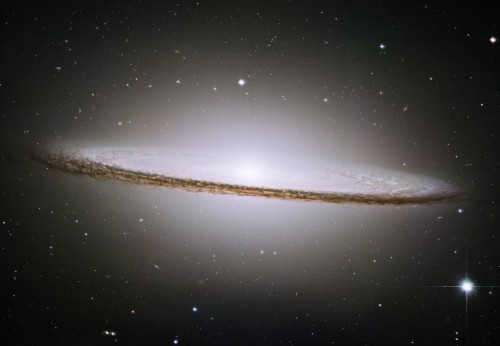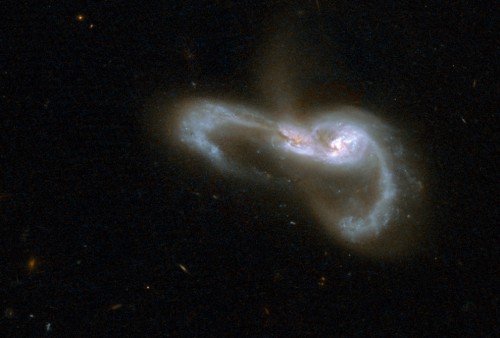
Messier 104 (M104), the Sombrero galaxy. has a brilliant white, bulbous core encircled by the thick dust lanes comprising the spiral structure of the galaxy. As seen from Earth, the galaxy is tilted nearly edge-on. We view it from just six degrees north of its equatorial plane. At a relatively bright magnitude of +8, M104 is just beyond the limit of naked-eye visibility and is easily seen through small telescopes. The Sombrero lies at the southern edge of the rich Virgo cluster of galaxies and is one of the most massive objects in that group, equivalent to 800 billion suns. The galaxy is 50,000 light-years across and is located 28 million light-years from Earth. X-ray emission suggests that there is material falling into the compact core, where a 1-billion-solar-mass black hole resides. In the 19th century, some astronomers speculated that M104 was simply an edge-on disk of luminous gas surrounding a young star, which is prototypical of the genesis of our solar system. But in 1912, astronomer V. M. Slipher discovered that the hat-like object appeared to be rushing away from us at 700 miles per second. This enormous velocity offered some of the earliest clues that the Sombrero was really another galaxy, and that the universe was expanding in all directions.

The Hubble Space Telescope caught the eerie, wispy tendrils of a dark interstellar cloud being destroyed by the passage of one of the brightest stars in the Pleiades star cluster. Like a flashlight beam shining off the wall of a cave, the star is reflecting light off the surface of pitch black clouds of cold gas laced with dust. These are called reflection nebulae.

VV 705, or Markarian 848, consists of two galaxies that seem to be embracing each other. Two long, highly curved arms of gas and stars emerge from a central region with two cores. One arm, curving clockwise, stretches to the top of the image where it makes a U-turn and interlocks with the other arm that curves up counter-clockwise from below. The two cores are 16,000 light-years apart. The pair is thought to be midway through a merger. Markarian 848 is located in the constellation of Bootes, the Bear Watcher, and is approximately 550 million light-years away from Earth.

The Hubble Space Telescope caught the eerie, wispy tendrils of a dark interstellar cloud being destroyed by the passage of one of the brightest stars in the Pleiades star cluster. Like a flashlight beam shining off the wall of a cave, the star is reflecting light off the surface of pitch black clouds of cold gas laced with dust. These are called reflection nebulae.
Hubble Space Telescope Advent Calendar 2009
Too many words?


























































Wicked cool.
omg 3rd pic is a galactic cock-n-balls
These are awesome and educational. Awsocational. It doesn’t hurt that I’ve always been interested in space.
So awesome. I read once about a yogi grandmaster who said he could astral travel through space. I gotta get back into yoga…
The last one reminds me of the Nexus/Ribbon from the TNG movie Generations.
This is so cool. And the reason we are Not Alone. (I feel all chummy, now!)
are you sure the first one isn’t a supergate?